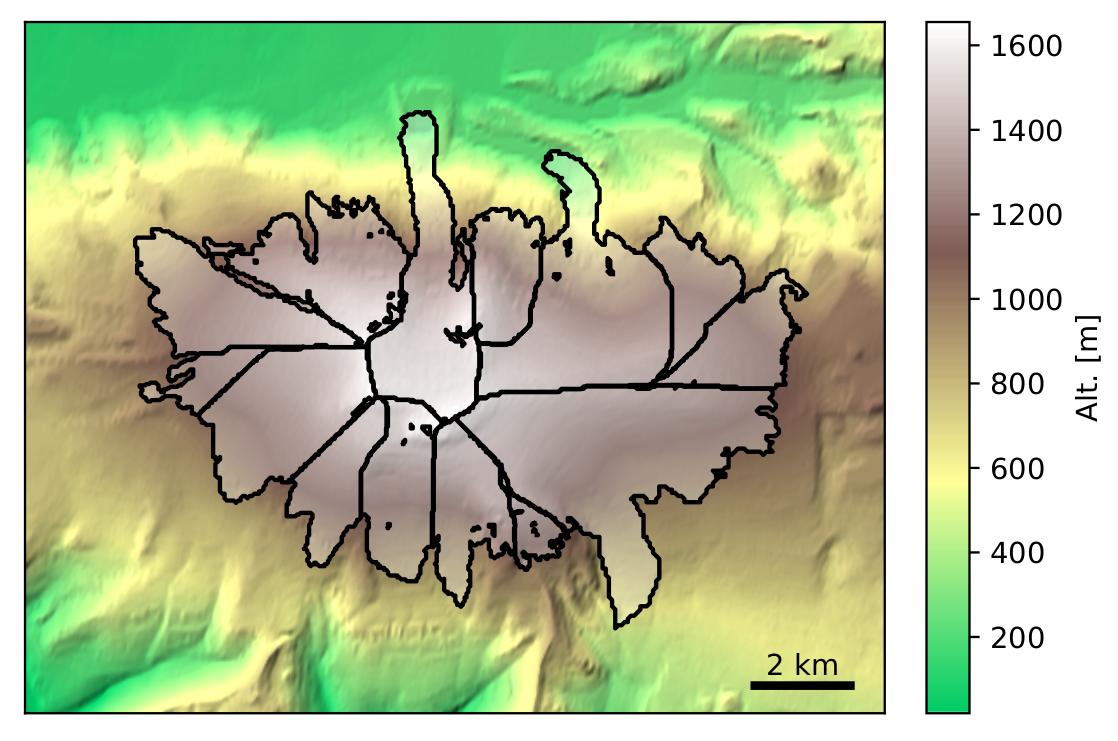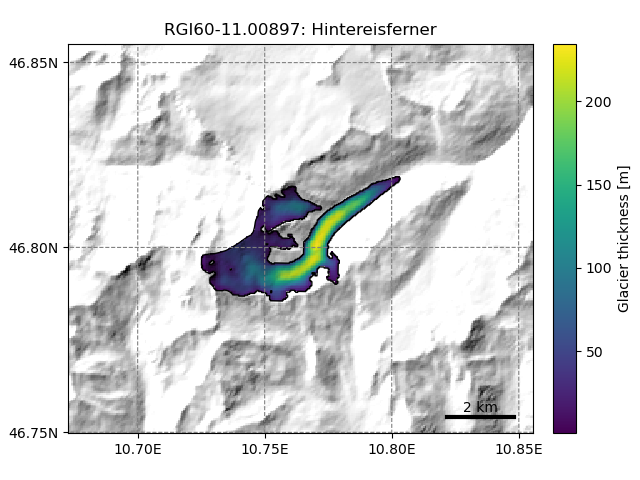Model structure and fundamentals#
Glacier centric model#
OGGM is what we called a “glacier centric model”, which means that it runs for each glacier independently of the others. In the case of glacier complexes, it relies on the glacier inventory to properly separate the individual glacier entities by the ice divides, ensuring that all ice in a glacier basin flows towards a single glacier terminus.

Glacier centric approach applied to the Eyjafjallajökull ice cap in Iceland. Glacier outlines provided by the Randolph Glacier Inventory v6.0.#
The glacier centric approach is used by most large-scale glacier models to date. Alternative strategies include global gridded approaches, where all glaciers in a model grid cell are added together and possibly organized into elevation bins. Another approach would be to handle entire glacier complexes as one single body of ice (“ice caps”). With the release of RGI7 (early 2022), OGGM will also be able to consider glacier complexes as if they were single glacier entities.
More details on the glacier centric approach
The advantage of glacier centric models is their adherence to the de-facto standard inventory of glacier outlines: the Randolph Glacier Inventory. Any glacier can be selected and simulated, and the model output can be compared to standard reference datasets such as length changes or surface mass balance data from the World Glacier Monitoring Service. Various models can be compared on a glacier per glacier basis or a combination of them. It is also computationally efficient, since models can focus on simulating the areas where glaciers are really located. This may sound trivial, but glacier centric models can also make use of the glacier location as a boundary condition, e.g. by excluding unrealistic solutions to the problem of computing mass balance or inferring ice thickness, for example.
The disadvantage of glacier centric models is their questionable scientific validity in presence of glacier complexes and ice divides (this problem can be mitigated by defining glacier complexes as one single entity, requiring other strategies than currently standard in OGGM). A larger issue of glacier centric models is that they are focused on simulating glaciers that have been inventoried, i.e. they cannot retrieve past (or present) uncharted glaciers. For these reasons, they are not well adapted for studying glacier evolution in climates when glaciers were widely different from today (e.g. the Last Glacial Maximum).
Data structures and glacier directories#
The fundamental data structure used in OGGM is the so-called Glacier Directory. Glacier directories are simple folders on disk which store the input and output data for a single glacier during a run. OGGM offers an interface to access and store these files programmatically.
This very simple idea is at the core of the OGGM workflow: actions to perform on glaciers (”tasks”, see below) are given access to the data files via the glacier directory interface, read data they need from disk, and write back to it. This design matches perfectly the “glacier centric” modelling strategy, and has many advantages as outlined below.
Here is an example of how glacier directories work in practice. The user
indicates a repository (base_url, here leading to
this online folder)
from which they want to fetch the data,
and a list of glacier IDs they’d like to start from. The
workflow.init_glacier_directories() task performs the action of
downloading and extracting these data locally:
In [1]: from oggm import workflow, tasks, graphics
In [2]: rgi_ids = ['RGI60-11.00897']
In [3]: gdirs = workflow.init_glacier_directories(rgi_ids, # glaciers to download
...: from_prepro_level=4, # pre-processing level
...: prepro_border=80, # pre-processing map size
...: prepro_base_url=base_url) # online repository
...:
In [4]: workflow.execute_entity_task(tasks.distribute_thickness_per_altitude, gdirs);
In [5]: graphics.plot_distributed_thickness(gdirs[0])

See also the documentation page for OGGM Shop for more examples of the kind of data that can be added to glacier directories.
More details: pros and cons of glacier directories
Pros:
there is no practical difference between simulating one single, or many glaciers: all glacier directories are independent of another.
data is persistent on disk: workflows can be interrupted and restarted from disk at no cost overhead. Workflows can even be prepared on one computer and restarted from another computer (see example).
“modularity” is achieved via data formats, not via programmatic interfaces: various ways to compute the flowlines (for example) can co-exist if they agree on how a flowline is stored on disk.
multiprocessing is trivial: the same task can be run on many glaciers at once without having to share data across processes, since everything is located on disk and independent.
Cons:
for the glacier directories to be independent, several data sources are duplicated: topography for example (each glacier has its own subset of the original data, often overlapping with neighbors), or climate timeseries (the same data from the same grid point is stored in various directories). This can lead to rather large data storage requirements, but can be mitigated by deleting intermediate files.
since users can restart workflows from pre-processed states, the code that was used to produce them is often ignored or might be older, etc. This can lead to silent bugs (for example mismatching model parameters between the preprocessing and the simulations, leading to incorrect results). Because of this issue, we had to implement safeguards against such mistakes wherever possible.
users can be confused by glacier directories. Since an OGGM program does not always read like linear “A to Z” workflows (but for example “start from Q, then do Q to Z”), mistakes like the ones described above can happen unnoticed.
it can make certain types of sensitivity experiments more difficult to implement, since users have to worry not only about variable names, but also about data file names.
OGGM tasks#
Tasks in OGGM are actions to perform on one single glacier (Entity tasks) or several of them (Global tasks). Tasks have a special meaning in the OGGM workflow and are applied as such:
# Initialize glacier directories
from oggm import workflow, tasks
gdirs = workflow.init_glacier_directories(rgi_ids, prepro_base_url=base_url)
# Define the list of tasks
task_list = [
tasks.define_glacier_region,
tasks.glacier_masks,
tasks.compute_centerlines,
tasks.catchment_area,
tasks.catchment_width_geom,
]
# Apply them sequentially
for task in task_list:
workflow.execute_entity_task(task, gdirs)
workflow.execute_entity_task() will apply the given task to a list of
glaciers. If multiprocessing is switched on, all glaciers will be processed in
parallel, making full use of all available processors. Here we apply the default
tasks with default settings, but parameters can be changed via global
settings or function arguments.
Depending on the desired set-up, tasks can be replaced by others (e.g. the centerlines tasks can be replaced by other algorithms) or omitted (for example, users can choose whether a quality check filter should be applied to the climate timeseries or not).
See this example from the documentation about how tasks can’t be interchanged to run OGGM with different types of flowlines.
Modularity#
Modularity in OGGM is achieved in two major ways:
object oriented programming (OOP) interfaces: OGGM relies on object interfaces to couple modelling elements between each other. A typical example are the
FlowlineModelandMassBalanceModelclasses which are use to couple the two models without enforcing any particular way to solve the glacier geometry evolution or the climatic mass balance.persistence on disk with Glacier Directories: as explained in the previous chapter, tasks can be interchanged during a processing workflow, allowing modularity as long as all tasks agree on the format of the file written on disk.
The object interfaces in particular are fundamental for anyone wanting to extend OGGM with their own parameterization. The OGGM-contrib repository illustrates how anyone can add a parameterization to OGGM without changing the OGGM codebase.
Preprocessing#
If you are looking for only ONE reason to use OGGM and create your own model on top of it, the OGGM pre-processing capabilities are probably it.
OGGM is designed for large-scale applications, i.e. we have pre-downloaded and pre-processed a large number of datasets that are ready to use from within the OGGM framework.
Visit OGGM Shop to learn all you need to know about the data we have prepared for you!
